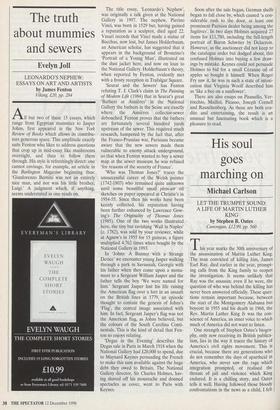The truth about mummies and sewers
Evelyn Joll
LEONARDO'S NEPHEW: ESSAYS ON ART AND ARTISTS by James Fenton Viking f20, pp. 284 All but two of these 15 essays, which range from Egyptian mummies to gasper Johns, first appeared in the New 1 York Review of Books which allows its contribu- tors generous space. This amplitude exactly suits Fenton who likes to address questions that crop up in mid-essay like mushrooms overnight, and then to follow them through. His style is refreshingly direct: one cannot envisage, for example, an article in the Burlington Magazine beginning thus: `Gianlorenzo Bernini was not an entirely nice man, and nor was his little brother, Luigi.' A judgment which, if anything, seems understated as one reads on. The title essay, `Leonardo's Nephew', was originally a talk given at the National Gallery in 1997. The nephew, Pierino Vinci, was born in 1529 but, having gained a reputation as a sculptor, died aged 22.
Vasari records that Vinci made a statue of Bacchus, now lost, but James Holderbaum, an American scholar, has suggested that it appears in the background of Bronzino's `Portrait of a Young Man', illustrated on the dust jacket here, and now on loan to the National Gallery. Holderbaum's theory, when reported by Fenton, evidently met with a frosty reception in Trafalgar Square.
`Seurat and the Sewers' has Fenton refuting T. J. Clark's claim in The Painting of Modern Life (1984) that in Seurat's great `Bathers at Asnieres' in the National Gallery the bathers in the Seine are exactly where the Asnieres collector-sewer debouched. Fenton proves that the bathers are fortunately several hundred yards upstream of the sewer. This required much research, hampered by the fact that, after the Franco-Prussian war, Parisians became aware that the new sewers made them vulnerable to enemy attack underground, so that when Fenton wanted to buy a sewer map at the sewer museum he was refused `for reasons of the security of France'.
`Who was Thomas Jones?' traces the unsuccessful career of the Welsh painter (1742-1803) who remained quite unknown until some beautiful small plein-air oil sketches on paper appeared at Christie's in 1954-55. Since then his works have been keenly collected, his reputation having been further enhanced by Lawrence Gow- ing's The Originality of Thomas Jones (1985). One of the two works illustrated here, the tiny but ravishing 'Wall in Naples' (c. 1782), was sold by your reviewer, while at Agnew's in 1955 for 15 guineas, a figure multiplied 4,762 times when bought by the National Gallery in 1993.
In 'Johns: A Banner with a Strange Device' we encounter young Jasper walking through a park in Savannah, Georgia with his father when they come upon a monu- ment to a Sergeant William Jasper and the father tells the boy 'We were named for him.' Sergeant Jasper lost his life raising the American flag over a fort in an assault on the British lines in 1779, an episode thought to contain the genesis of Johns's `Flag', the central image associated with him. In fact, Sergeant Jasper's flag was not the American flag, as Johns believed, but the colours of the South Carolina Conti- nentals. This is the kind of detail that Fen- ton so enjoys relating.
`Degas in the Evening' describes the Degas sale in Paris in March 1918 when the National Gallery had £20,000 to spend, due to Maynard Keynes persuading the French to make this sum available against the huge debt they owed to Britain. The National Gallery director, Sir Charles Holmes, hav- ing shaved off his moustache and donned spectacles as cover, went to Paris with Keynes. Soon after the sale began, German shells began to fall close by, which caused 'a con- siderable rush to the door, at least one prominent Parisian dealer being among the fugitives'. In two days Holmes acquired 27 items for £11,780, including the full-length portrait of Baron Schwiter by Delacroix. However, as the auctioneer did not keep to the catalogue order but dodged about, this confused Holmes into buying a few draw- ings by mistake. Keynes could not persuade Holmes to bid for a small Cezanne oil of apples so bought it himself. When Roger Fry saw it, he was in such a state of intoxi- cation that Virginia Woolf described him as 'like a bee on a sunflower'.
There are also essays on Pisanello, Ver- rocchio, Maillol, Picasso, Joseph Cornell and Rauschenberg. As these are both eru- dite and entertaining, the result is an unusual but fascinating book which is a pleasure to read.










































































 Previous page
Previous page